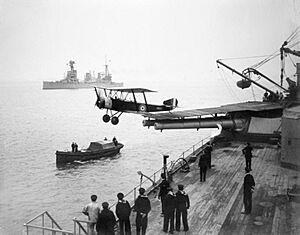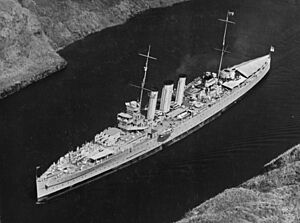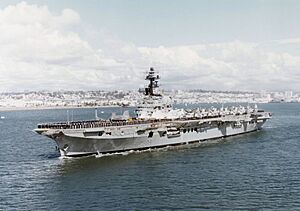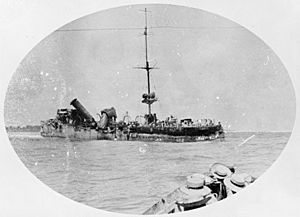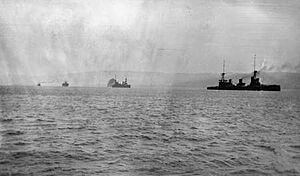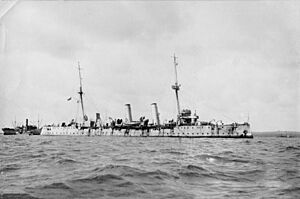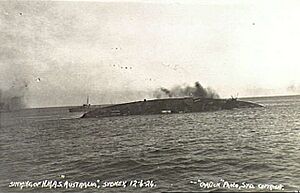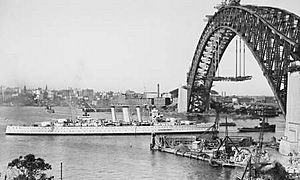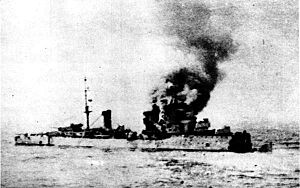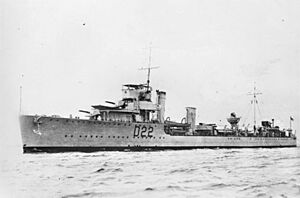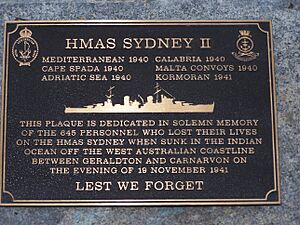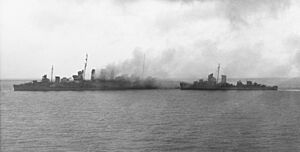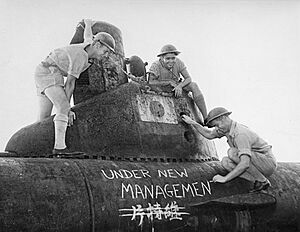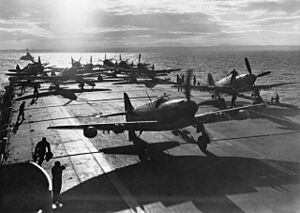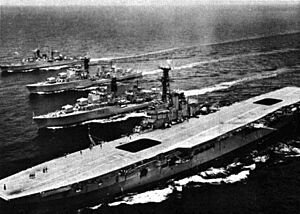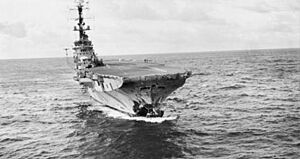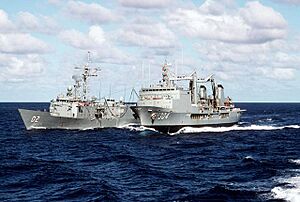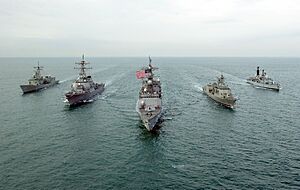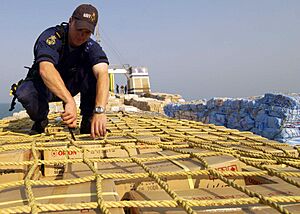History of the Royal Australian Navy facts for kids
The history of the Royal Australian Navy (RAN) tells the story of how Australia's navy grew from when the British first settled Australia in 1788. At first, British Royal Navy ships often visited the new colonies. In 1859, the Australia Squadron was created just for Australia. It stayed here until 1913. Before Australia became one country (Federation) in 1901, five of the six colonies had their own small navies. These forces joined together on 1 March 1901 to form the Commonwealth Naval Force. In July 1911, King George V gave it the title "Royal Australian Navy." On 4 October 1913, the new fleet sailed into Sydney Heads for the very first time.
The Royal Australian Navy has fought in oceans all over the world. It first saw action in World War I in the Pacific, Indian, and Atlantic oceans. Between the two World Wars, the RAN's size changed with Australia's money situation. It grew a lot in the 1920s but had to shrink its fleet and operations in the 1930s. Because of this, when World War II started, the RAN was smaller than it had been at the start of World War I. During World War II, the RAN used more than 350 fighting and support ships. Another 600 small civilian boats also helped as patrol boats.
After World War II, the RAN fought in the Korean War, Vietnam War, and other smaller conflicts. Today, the RAN is a small but modern navy. It is seen as one of the strongest naval forces in the Asia Pacific Region.
Contents
- How the Royal Australian Navy Began
- The RAN in World War I
- Between the World Wars
- The RAN in World War II
- The RAN During the Cold War
- The RAN After the Cold War
- Battle Honours and Women in the RAN
- The Royal Australian Navy Today
- Images for kids
In the years after the British colony of New South Wales was set up in 1788, ships from the Royal Navy's East Indies Squadron often visited Australian waters. From the 1820s, a ship was sent every year to New South Wales and sometimes to New Zealand.
In 1859, the British Navy created a special command called the Australia Station. This was led by a Commodore. The Australian Squadron was formed for British naval ships serving in this area. This change happened because a large part of the East Indies Station was already in Australian waters. It also showed growing concern for the Pacific Ocean, especially around Tahiti and New Zealand. In 1884, the commander of the Australia Station became a rear admiral.
When it started, the Australia Station covered Australia and New Zealand. Its eastern border included Samoa and Tonga, and its western edge was in the Indian Ocean. Its southern border was the Antarctic Circle. The borders changed in 1864, 1872, and 1893. At its biggest, the Australia Station stretched from the Equator to the Antarctic. It covered a quarter of the Southern Hemisphere, including Papua New Guinea, New Zealand, Melanesia, and Polynesia.
In 1911, the Australia Station was handed over to the Commonwealth Naval Forces. The Australian Squadron was then ended. The Station, now under Australian command, only covered Australia and its nearby islands. In 1911, the Commonwealth Naval Forces became the Royal Australian Navy. In 1913, it came fully under Australian command. The Royal Navy gave its Sydney bases and dockyards to Australia. The Royal Navy continued to help the RAN and provided strong naval defence in the Pacific until World War II.
Before Australia became a federation in 1901, five of the six self-governing colonies had their own navies. Western Australia was the only one without a naval force. The Royal Navy's Australian Station, set up in 1859, supported these colonial navies. In 1856, Victoria got its own naval ship, HMCSS Victoria. In 1860, this ship helped the New Zealand government during the First Taranaki War. When Victoria returned to Australia, it had been in several small battles. This was the first time an Australian warship had been sent overseas.
In the years before Federation, Victoria had the strongest colonial navy. Victoria had HMVS Cerberus since 1870, plus HMVS Nelson, three small gunboats, and five torpedo-boats. New South Wales had two small torpedo boats and the corvette Wolverine. The colonial navies grew a lot in the mid-1880s. They usually had gunboats and torpedo-boats for defending harbours and rivers. They also had naval brigades to staff ships and forts.
On 1 January 1901, Australia became a federation of six States, called the Commonwealth of Australia. On 1 March 1901, the Commonwealth took over the defence forces from the States. This formed the Commonwealth Naval Forces. The Australian and New Zealand governments agreed to help pay for the Royal Navy's Australian Squadron. In return, the British Navy promised to keep the Squadron strong. In 1902, the commander of the Australia Station was promoted to vice admiral. The borders were changed again in 1908.
More and more people, including Captain William Rooke Creswell, wanted Australia to have its own navy. This navy would be paid for and controlled by Australia. In 1907, Prime Minister Alfred Deakin and Creswell asked the British Government to stop the subsidy system. They wanted to build an Australian navy. The British Navy said no, but suggested a small fleet of destroyers and submarines would be enough.
Deakin was not happy with this. In 1908, he invited the United States Great White Fleet to visit Australia. This visit made the public excited about having a modern navy. It led to the order of two 700-ton destroyers. In 1909, Germany started building many naval ships. This made the British Navy change its mind about an Australian navy. As a result, the Naval Defence Act of 1910 was passed, which created the Australian navy.
The first Australian warship, the destroyer HMAS Parramatta, was launched in Scotland on 9 February 1910. Her sister ship HMAS Yarra was launched on 9 April 1910. Both ships joined the Royal Navy on 19 September 1910 and sailed to Australia. They arrived at Port Phillip on 10 December 1910.
The British Australia Station was given to the Commonwealth Naval Forces in 1911. The Australian Squadron was then ended. On 10 July 1911, King George V gave the name "Royal Australian Navy" to the Commonwealth Naval Forces. RAN ships could then use the prefix "His Majesty's Australian Ship" (HMAS). The Station was reduced to cover Australia and its islands to the north and east. New Zealand became part of the China Station. The Navy was controlled by the Australian Commonwealth Naval Board, which started on 1 March 1911.
At the 1911 Imperial Conference, Australia worried about Japan's growing naval power. It was agreed that the British government would talk to Australia when renewing the Anglo-Japanese Alliance. It was also decided that the Royal Navy would keep helping the RAN and provide strong defence in the Pacific. If there was a war, RAN ships would be controlled by the British Navy. Under the Naval Defence Act (1912), the Governor-General of Australia could make this transfer. The RAN would become the Australia Squadron of the Royal Navy. All ships and personnel would be under direct British control, but the RAN would still be responsible for ship upkeep and training.
In 1913, the new Royal Australian Navy took over the reduced Australia Station. The Royal Navy's Australia Squadron ended, and its Sydney bases were given to Australia. The first commanding officer was Admiral George Edwin Patey, on loan from the Royal Navy. On 4 October 1913, the Australian fleet entered Sydney Harbour for the first time. It included the battle cruiser Australia, the cruisers Melbourne and Sydney, the protected cruiser Encounter, and the destroyers Parramatta, Yarra, and Warrego. The fleet had 400 officers and men. For the next two years, more ships were built for the new navy.
The Royal Navy continued to support the RAN and provide strong naval defence in the Pacific until the early years of World War II. In 1958, the Australia Station's borders were changed again to include Papua New Guinea.
The RAN in World War I
On 3 August 1914, as war with Germany seemed likely, the Australian Government told the British Navy it was ready to put its ships under British control. The United Kingdom declared war on Germany the next day. On 8 August, Australia was asked to make the transfer immediately. Two days later, on 10 August, the Governor-General officially transferred control of the Royal Australian Navy to the British Navy. This control lasted until 19 August 1919.
When the war started, the RAN had 3,800 people and sixteen ships. These included the battlecruiser Australia, the light cruisers Sydney and Melbourne, the destroyers Parramatta, Yarra, and Warrego, and the submarines AE1 and AE2. The light cruiser Brisbane and three destroyers were still being built. A small fleet of support ships was also ready. So, at the start of the war, the Royal Australian Navy was small but strong.
Australian ships first fought in the Pacific. They helped attack German New Guinea with the Australian Naval and Military Expeditionary Force (AN&MEF). Germany had taken over the northeastern part of New Guinea in 1884. This colony had a wireless radio base that the German fleet used. Britain wanted these wireless stations destroyed because they threatened merchant ships. The targets were German stations at Yap, Nauru, and Rabaul.
On 30 August 1914, the AN&MEF left Sydney with protection from Australia and Melbourne. They went to Port Moresby and met the Queensland group. The force then sailed for German New Guinea on 7 September. Melbourne was sent to destroy the wireless station on Nauru. On 14 September, Encounter fired shells near Rabaul. The only major loss was the submarine AE1, which disappeared during a patrol off Rabaul on 14 September 1914.
On 9 November 1914, the German light cruiser SMS Emden attacked the Allied radio station at Direction Island. The islanders sent a distress signal, which Sydney received. Sydney was only 50 miles (80 km) away. Sydney arrived within two hours and fought Emden. Sydney was bigger, faster, and had better weapons. It eventually defeated Emden. Captain Karl von Müller ran his ship aground on North Keeling Island. Emden at first refused to surrender, so Sydney kept firing until it finally gave up. The Battle of Cocos was the first battle the RAN took part in.
On 6 February 1915, the older light cruiser HMAS Pioneer joined the East African campaign. On 6 July, it fought the German cruiser SMS Königsberg and German shore batteries during the Battle of Rufiji Delta. Pioneer stayed off East Africa and helped shell German East Africa, including Dar-es-Salaam on 13 June 1916. Pioneer then returned to Australia and was taken out of service in October 1916.
During the Naval operations in the Dardanelles Campaign, the Australian submarine AE2 was the first Allied warship to get past the Turkish defences of the Dardanelles. AE2 spent five days in the area. It was attacked several times but could not find any large enemy troop ships. On 29 April 1915, it was damaged in an attack by the Turkish torpedo-boat Sultan Hisar. Its crew sank the submarine. The wreck of AE2 was not found until June 1998.
Ships of the Royal Australian Navy also helped the Royal Navy block the German High Seas Fleet. In February 1915, HMAS Australia joined the British Grand Fleet. It became the main ship of the 2nd Battle Cruiser Squadron. Australia was not in the Battle of Jutland. In April, the battlecruiser was damaged in a crash with its sister ship HMS New Zealand. It did not return to service until June. Three RAN ships were there when the German High Seas Fleet surrendered: Australia, Sydney, and Melbourne. Australia led the Grand Fleet as it sailed to meet the Germans.
The most decorated Australian Naval unit of World War One was not a ship. It was the Royal Australian Navy Bridging Train. This was a land-based unit mostly made of reservists. They landed at Suvla Bay with the British IX Corps. Their job was to receive, store, and give out supplies, including water, to the British troops at Suvla. Because they worked at the piers and landings, the Train was the last Australian unit to leave the Gallipoli Peninsula. After Gallipoli, the Train went to the Middle East. They made a second landing at the Battle of Magdhaba. Then they returned to Australia and were disbanded in May 1917.
The RAN grew to include 37 ships and more than 5,000 people by 1918. The RAN's losses were small. It only lost the two submarines AE1 and AE2. Casualties included 171 deaths. 108 were Australians, and 63 were officers and men on loan from the Royal Navy. Less than a third of these deaths were from enemy action.
Between the World Wars
After World War I, the Australian Government wanted to check the RAN's strength. Australia had based its naval policy on the Henderson Recommendations from 1911. The government invited Admiral John Jellicoe. He arrived in Australia in May 1919. Jellicoe stayed for three months before returning to England. He gave his findings in August 1919 in a report called the Report on the Naval Mission to the Commonwealth.
The report suggested ways to make British naval strength in the Pacific Ocean stronger. It strongly emphasized a close relationship between the RAN and the Royal Navy. This would happen by following the Royal Navy's procedures. The report also suggested officers from both navies should regularly swap places. Jellicoe also wanted a large Far East Imperial Fleet based in Singapore. This fleet would include large warships and aircraft carriers. The cost would be split between Great Britain (75%), Australia (20%), and New Zealand (5%). The RAN, he suggested, should have one aircraft carrier, two battlecruisers, eight light cruisers, twelve destroyers, eight submarines, and other support ships. The yearly cost was estimated at over £4 million. However, except for closer ties with the Royal Navy, most of Jellicoe's main ideas were not carried out.
After World War I, the Australian Government worried about the threat from Japan. Japan had expanded its empire 3,000 km (1,900 mi) south, very close to Australia. Japan kept building up its navy and became stronger than the Royal Navy in the Pacific. The RAN and the government thought a Japanese invasion was very likely. Admiral Jellicoe believed this threat would remain as long as the White Australia Policy was in place. Because of this perceived threat, Australia strongly supported continuing the Anglo-Japanese Alliance from 1902. New Zealand also supported it, but Canada was against it. Canada believed the alliance hurt Britain's relationship with China and the United States. No decision was made on the alliance until the Washington Naval Treaty.
The results of the treaty allowed the British to keep naval power in the Pacific. This made Australia feel safer. Many Australians thought the Four Powers Pact replaced the Anglo-Japanese Alliance. This feeling of safety was called the Ten Year Rule. It led to cuts in defence spending in Australia, following a global trend. Spending was reduced by £500,000. The Governor-General Henry Forster said in 1922: "Because of the Washington Treaty, which my advisors believe guarantees peace in the Pacific for some time, we plan to reduce the navy and army, and delay expanding the air force."
Between World War I and World War II, the Royal Australian Navy became much smaller in ships and people. Because of the Washington Naval Treaty, the main ship HMAS Australia was broken up and sunk outside Sydney Heads in 1924. In the same year, the RAN started a five-year plan to get new ships from Britain. These included the heavy cruisers Australia and Canberra, and the seaplane carrier Albatross. This purchase was partly paid for by scrapping Brisbane, Melbourne, Sydney, and most of the destroyers.
The Great Depression of 1929 led to another reduction in staff. Even though the navy was smaller, jobs were easy to fill because many men were unemployed, and the pay was good. The RAN's staff dropped to 3,117 people, plus 131 members of the Naval Auxiliary Services. By 1932, the Reserves had 5,446 people. In the early 1930s, lack of money forced the Royal Australian Naval College to move from Jervis Bay to Flinders Naval Depot in Victoria. In 1933, the Australian Government ordered three light cruisers: HMA Ships Perth, Hobart, and Sydney. They sold the seaplane carrier Albatross to pay for Hobart. During this time, the RAN also bought destroyers that became known as the Scrap Iron Flotilla. With the growing threat from Germany and Japan in the late 1930s, the RAN was not as strong as it had been at the start of World War I.
The RAN in World War II
Australia declared war on Nazi Germany one hour after the United Kingdom did, on 3 September 1939. Unlike World War I, RAN ships remained under Australian command during World War II.
| Ship type | Sept. 1939 |
June 1945 |
|---|---|---|
| Heavy cruisers | 2 | 2 |
| Light cruisers | 4 | 2 |
| Destroyers | 5 | 11 |
| Frigates | 0 | 6 |
| Sloops | 2 | 2 |
| Corvettes | 0 | 53 |
| Landing ship infantry | 0 | 3 |
| Anti-submarine auxiliaries | 0 | 3 |
| Auxiliary Minesweepers | 0 | 6 |
| Minelayers | 0 | 1 |
| Replenishment oilers | 0 | 1 |
| Combat stores ships | 0 | 12 |
| Repair ships | 0 | 3 |
| Net laying ships | 0 | 10 |
| Tugs | 0(?) | 6 |
| Cable repair ships | 0 | 2 |
| Survey ships | 0(?) | 9 |
| Motor Launches | 0 | 33 |
| Harbour Defence Motor Launches | 0 | 28 |
| Air Sea Rescue vessels | 0 | 20 |
| Auxiliary patrol boats | 0 | 75 |
| Services reconnaissance | 0 | 8 |
| Other vessels | 0(?) | 41 |
| Total | 13(?) | 337 |
At the start of the war, the RAN was quite small but ready for combat. Its main ships included:
- Two County-class heavy cruisers: Australia and Canberra. Both had 8-inch guns and started service in the 1920s.
- Three modern Modified Leander-class light cruisers: Hobart, Perth, and Sydney. These had 6-inch guns.
- The older Town-class cruiser Adelaide.
- Four sloops: Parramatta, Swan, Warrego, and Yarra. Only Swan and Yarra were in active service.
- Five V-class destroyers.
- Various support ships.
After calling up reserves in 1939, the number of permanent staff grew from 5,440 to 10,259.
During the war, RAN sailors and ships served in every area of operations, from the warm Pacific to the icy Russian convoys. The navy grew very quickly. The table shows how the RAN grew between the start of the war in September 1939 and June 1945.
Fighting in the Mediterranean and Atlantic
From mid-1940, RAN ships began to go to the Mediterranean Sea. The British Navy asked them to help in the Battle of the Mediterranean against Germany and Italy. In September 1939, the British and Australian navies agreed to send the RAN Destroyer Flotilla outside Australia. The five ships, later known as the Scrap Iron Flotilla, arrived in Malta in mid-December. HMAS Sydney went there in May 1940, and Hobart joined later. When Italy declared war on 10 June 1940, Australian warships made up five of the 22 Allied destroyers and one of the five modern light cruisers in the Mediterranean. The RAN then offered Australia to the British Navy, which was accepted. When Australia arrived, the RAN had sent almost its entire fighting fleet to the Northern Hemisphere. This left Australia open to possible attack.
Italy joining the war also meant the few remaining RAN ships in Australia had to do more. On 12 June 1940, after a long chase, the Armed Merchant Cruiser (AMC) HMAS Manoora forced the Italian merchant ship Romolo to sink south-west of Nauru.
On 28 June 1940, HMAS Sydney and other ships fought three Italian destroyers. Sydney was ordered to sink the Espero. Sydney fired four rounds, hitting Espero ten times. Sydney stayed for two hours to rescue survivors.
Also on 27 June 1940, the Console Generale Liuzzi was sunk south of Crete after being attacked by HMAS Voyager and British destroyers. On 29 June 1940, another Italian submarine, the Uebi Scebeli, was sunk west of Crete by the same ships.
On 9 July 1940, four RAN ships – HMA Ships Sydney, Stuart, Vampire, and Voyager – took part in the Battle of Calabria. Sydney was the first RAN ship to fight the enemy. It opened fire on an Italian cruiser. When the Italian fleet started to leave, the Allied destroyers were ordered forward. Stuart led the destroyers and was the first to fire, hitting a direct shot from far away. Both fleets left, but Italian planes kept attacking Allied ships. Sydney was heavily attacked by air and was thought to have sunk. The fleet returned to Alexandria on 13 July.
On 19 July 1940, HMAS Sydney and the destroyer HMS Havock were sent to help British destroyers north of Crete. They saw two Italian cruisers, Giovanni dalle Bande Nere and Bartolomeo Colleoni. The British destroyers retreated, while Sydney and Havock moved closer. Sydney fired the first shots of the Battle of Cape Spada. Within minutes, Sydney damaged Bande Nere. When the Italians left, the Allied ships chased them. Sydney then focused on Bartolomeo Colleoni, which was disabled. Sydney chased Bande Nere but stopped because it was too far away and Sydney was low on ammunition. Sydney was only hit once, which made a hole in its front funnel and wounded a sailor.
On 30 September 1940, HMAS Stuart destroyed the Italian submarine Gondar, killing two of its crew. Stuart rescued 28 survivors.
On 27 March 1941, an Allied fleet was ambushed by an Italian naval force off Cape Matapan, Greece. Three RAN ships – HMA Ships Perth, Stuart, and Vampire – took part. The victory at Cape Matapan allowed thousands of Allied troops to be evacuated from Crete.
HMAS Parramatta was sunk by a German submarine on 27 November 1941 while helping supply Allied troops at Tobruk. 24 people survived, but 138 men, including all officers, died.
The Australians had more success on 15 December 1941 when HMAS Nestor attacked and sank the German submarine U-127 off Cape St. Vincent, Portugal.
The "Scrap-Iron Flotilla"
The Scrap Iron Flotilla was a group of Australian destroyers that fought in the Mediterranean and Pacific during World War II. The name was given by Nazi Propaganda Minister Joseph Goebbels, who called the fleet a "consignment of junk" and "Australia's Scrap-Iron Flotilla". The flotilla had five ships: Scott-class destroyer HMAS Stuart, which led the group, and four V-class destroyers: Vampire, Vendetta, Voyager, and Waterhen. All these ships were built for World War I and were slow and not as well-armed as newer ships. The five destroyers, which were all of the RAN's destroyer force, left Australia in November 1939. They went to Singapore to practice anti-submarine drills with a British submarine. On 13 November 1939, the flotilla left Singapore for the Mediterranean Sea after the British Navy asked for help.
The Australian destroyer flotilla took part in many actions in the Mediterranean. This included the Allied evacuation after the Battle of Greece in April 1941. However, the flotilla became famous for its mission to resupply the besieged city of Tobruk. The supply routes from Alexandria and Mersa Matruh to Tobruk were called "Bomb Alley" because of constant enemy air attacks. The flotilla, which was in poor condition by this time, managed to make 138 supply runs to Tobruk. They carried in ammunition and supplies and took out wounded soldiers. On 28 May 1941, Vampire was the first of the flotilla to leave the Mediterranean. Vendetta, the last one, sailed in October 1941.
Of the five destroyers, three were lost during the war. Waterhen was sunk in the Mediterranean on 30 June 1941. Vampire was sunk by Japanese aircraft during the Indian Ocean Raid. Voyager ran aground at Betano during the Timor campaign and was abandoned.
Loss of HMAS Sydney
On 19 November 1941, the Australian light cruiser HMAS Sydney and the German merchant raider Kormoran fought each other in the Indian Ocean, off Western Australia. Both ships sank. Sydney was lost with all 645 people on board. Most of the Kormoran's crew were rescued and became prisoners of war. The location of both wrecks was a mystery until 16–17 March 2008, when both ships were found.
War with Japan
After the Imperial Japanese Navy attacked the Allies in December 1941, the RAN sent its larger ships back to Australia. This was to protect the Australian mainland from Japanese attack. Several smaller ships stayed in the Mediterranean. From 1940 onwards, there was a lot of Axis naval activity in Australian waters. First, German merchant raiders and submarines, and later the Imperial Japanese Navy, were active.
Initially, RAN ships served as part of the British-Australian section of the American-British-Dutch-Australian Command (ABDACOM) naval forces. ABDACOM was closed after the fall of the Netherlands East Indies. It was replaced by the South West Pacific Area (command) (SWPA). The United States Seventh Fleet was formed in Brisbane on 15 March 1943, for service in the SWPA. RAN ships in the Pacific usually served as part of Seventh Fleet taskforces.
Timor
From February 1942, the RAN played a very important role in supplying Australian and Dutch commandos on Timor. Voyager was not the only loss during this campaign. On 1 December 1942, HMAS Armidale was attacked by 13 Japanese aircraft. It was trying to land Dutch soldiers off Betano, Portuguese Timor. Armidale sank, and 40 of its crew and 60 Dutch soldiers were lost. During the fight, Ordinary Seaman Teddy Sheean operated an Oerlikon anti-aircraft gun. He was wounded by Japanese planes but went down with the ship, still firing at the attacking aircraft.
Java Sea
On 28 February 1942, an Allied naval force met a Japanese invasion force in the Java Sea. The cruiser HMAS Perth and the American heavy cruiser USS Houston fought in and survived the Battle of the Java Sea.
On 1 March 1942, Perth and Houston tried to go through the Sunda Strait. However, they found their way blocked by the main Japanese invasion fleet. The Allied ships were attacked by at least three cruisers and several destroyers. In a fierce night battle, known as the Battle of Sunda Strait, both Perth and Houston were torpedoed and sank. On Perth, 350 crew and 3 civilians were killed. 324 survived and were taken prisoner by the Japanese. 106 of these later died in captivity. The loss of Perth so soon after Sydney had a big emotional impact on Australians. Japanese losses included a minesweeper and a troop transport sunk by their own side. Three other transports were damaged and had to be run aground.
Coral Sea
On 2 May 1942, two RAN ships, HMA Ships Australia and Hobart, were part of the Allied force in the Battle of the Coral Sea. They were part of a group guarding the approaches to Port Moresby and came under heavy air attack.
Defending Australian Shipping
In late May and early June 1942, five Japanese submarines attacked Sydney and the nearby port of Newcastle. On the night of 31 May – 1 June, the submarines launched three midget submarines into Sydney Harbour. A torpedo meant for the cruiser USS Chicago exploded under the depot ship HMAS Kuttabul, killing 21 people. On 8 June, two of the submarines shelled Sydney and Newcastle, but caused little damage. In response, the RAN started convoys between Brisbane and Adelaide. All ships over 1,200 tons and slower than 12 knots (22 km/h) had to sail in convoy when traveling along the east coast.
The attack on Sydney and Newcastle started a long Japanese submarine campaign against Australia. In 1942, Japanese submarines sank 17 ships in Australian waters. In 1943, 16 ships were sunk before the Japanese ended the campaign in July. Five of these ships were sunk while in escorted convoys. The Australian navy slowly stopped the coastal convoy system between December 1943 and March 1944. By the end of the war, the RAAF and RAN had escorted over 1,100 convoys along the Australian coast.
While the Japanese naval attacks on Australia were small compared to other naval campaigns, they were "the most complete and widespread series of attacks ever made by an enemy against Australia." Although the RAN only sank one full-sized Japanese submarine in Australian waters (I-124 in January 1942), convoy escorts likely helped reduce the threat to shipping by making it harder for Japanese submarines to attack.
While escorting convoys between Australia and New Guinea, HMAS Arunta attacked and sank the Japanese submarine Ro-33 off Port Moresby on 24 August 1942. All 42 men on board died.
Loss of HMAS Canberra
The loss of HMAS Canberra at the Battle of Savo Island in August 1942 was the biggest single ship loss for the RAN during World War II. In the early hours of 9 August 1942, Canberra was badly damaged off Guadalcanal in a surprise attack by a strong Japanese naval force. Canberra was hit by 24 shells in less than two minutes. 84 of its crew were killed, including Captain Frank Getting. After an order to abandon ship, Canberra was sunk the next day by a torpedo from a US destroyer to prevent it from being captured.
The loss of Canberra, after Sydney and Perth were lost, brought a lot of international attention and sympathy for the RAN. US President Franklin D. Roosevelt wanted to remember the loss of Canberra. He asked that a US heavy cruiser being built be named Canberra. USS Canberra was launched on 19 April 1943. The British Government approved giving HMS Shropshire to the RAN as a replacement. The ship was named HMAS Shropshire on 20 April 1943.
Leyte Gulf and Lingayen Gulf
Between 23 and 25 October 1944, four RAN warships – HMA Ships Australia, Shropshire, Arunta, and Warramunga – took part in the Battle of Leyte Gulf. This was one of the largest naval battles in history. On 21 October, before the main battle, Australia became the first Allied ship to be hit by a kamikaze aircraft near Leyte Island. Gunners from Australia and Shropshire fired at a Japanese aircraft. The plane then flew away, turned, and crashed into Australia. It hit the ship's upper structure above the bridge, spraying burning fuel and debris. A 200 kg (440 lb) bomb on the plane did not explode. If it had, the ship might have been destroyed. At least 30 crew members died, including the commanding officer, Captain Emile Dechaineux. Among the wounded was Commodore John Augustine Collins, the Australian force commander. Australia stayed on duty, but on 25 October, it was hit again. It had to go to the New Hebrides for repairs.
Shropshire and Arunta stayed at Leyte. They were part of the United States Seventh Fleet Support Force at the Battle of Surigao Strait on 25 October. During this action, both ships helped sink the Japanese battleship Yamashiro. Shropshire fired 32 rounds from its 8-inch guns into the battleship in 14 minutes.
HMAS Australia returned to battle at the Battle of Lingayen Gulf in January 1945. During this battle, Australia was attacked repeatedly between 5–9 January. It suffered major damage and was forced to leave again.
Ships with British Fleets 1942–45
From late 1944, Nepal, Norman, and Quiberon were transferred to the new British Pacific Fleet (BPF). They took part in the Battle of Okinawa.
The End of World War II in 1945
By the end of World War II, the RAN had 150 fighting ships and another 200 support boats. The navy reached its largest size in June 1945, with 39,650 people. During the six years of war, the RAN lost three cruisers, four destroyers, two sloops, a corvette, and a minesweeper to enemy action. 1,740 people died from the 19 ships sunk. Another 436 people were killed on other ships or at other places. These losses were heavy for such a small navy. The RAN destroyed one cruiser, an armed merchant raider, three destroyers, a minesweeper, many small boats, and seven submarines. It also destroyed or captured over 150,000 tons of enemy merchant ships and shot down over a hundred aircraft.
Surrender and Occupation of Japan

Ten RAN ships were present at the signing of the Japanese surrender in Tokyo Bay on 2 September 1945. These included HMA Ships Ballarat, Cessnock, Gascoyne, Hobart, Ipswich, Napier, Nizam, Pirie, Shropshire, and Warramunga. After the surrender, most RAN ships left Japanese waters for other duties. As part of the surrender, Japan agreed to be occupied and disarmed by the Allies. On 17 August 1945, the Australian Government agreed to provide two cruisers and two destroyers for the British Commonwealth Occupation Force (BCOF). A total of 15 RAN ships served with the BCOF. They did many tasks, but mainly patrolled Kyushu to stop Koreans from illegally entering Japan.
The RAN also helped disarm Japan. They helped sink former Japanese Navy ships. For example, Quiberon helped sink seven submarines off Kyushu. When Indian and New Zealand groups left the BCOF, it became mostly an Australian operation. In 1948, Kure naval base was given to Australia and became known as HMAS Commonwealth. When North Korea invaded South Korea on 25 June 1950, one RAN ship was there as part of BCOF. The Australian Government immediately offered HMAS Shoalhaven for United Nations service. Eventually, all RAN ships in the area were transferred to the command of British Commonwealth Forces Korea (BCFK).
Clearing mines from Australian and New Guinean waters was another important job for the RAN after the war. Minesweeping began in December 1945. It was done by HMAS Swan, eight Bathurst-class corvettes, and smaller boats from a base at Cairns. The work was hard and dangerous. HMAS Warrnambool sank on 13 September 1947 after hitting a mine off North Queensland. Four men were killed, and 25 were wounded. The RAN finished this task in August 1948 after clearing 1,816 mines.
The RAN During the Cold War
After World War II, the RAN made its surface fleet smaller but grew in other ways. It bought two British aircraft carriers (HMAS Melbourne and HMAS Sydney) to build up its Fleet Air Arm. In the 1960s, the RAN started to move away from British-designed ships. The last major British design used was the Type 12 frigate, which became the basis for the River-class frigates.
When the RAN decided to get a destroyer with guided missiles, the British Type 12 frigate was an option. However, the RAN had concerns about its engines and missile system. Instead, the Australian government chose the American-built, steam-powered Charles F. Adams-class destroyer, armed with the Tartar missile. This became the basis for its Perth class, the first major US warship design chosen for the RAN.
By the mid-to-late 1960s, the RAN was at its strongest. It could send a full carrier battle group to support major operations. It had an aircraft carrier (HMAS Melbourne), three large area defence destroyers, six modern frigates, and four submarines.
When British forces left areas west of the Suez Canal in the 1960s, the RAN started to focus more on defending Australia. It worked with the United States through the ANZUS treaty. The RAN served in many post-war conflicts, including Korea, Vietnam, and the Indonesian Confrontation.
Korea
On 27 June 1950, the United Nations Security Council asked member nations to help South Korea. On 29 June, Prime Minister Robert Menzies announced that the frigate HMAS Shoalhaven (in Japan) and the destroyer HMAS Bataan (in Hong Kong) would be placed under UN command in Korea. On 1 July, the first Australian operation in Korea happened. Shoalhaven escorted an American ammunition ship from Japan to Pusan.
The destroyer Warramunga was sent in July 1950. It provided gunfire support during the X Corps landing at Wonsan in October. In December, Bataan and Warramunga helped evacuate many troops and refugees from Hungnam. The aircraft carrier Sydney was sent to Korea between September 1951 and January 1952. This was the first carrier owned by a Commonwealth country to see wartime service. During this time, 2,366 flights were made from Sydney. Only 15 aircraft were lost, and three pilots were killed.
During the Korean War, nine RAN ships took part in the naval blockade of North Korea.
Indonesia-Malaysia Confrontation
In response to Indonesia's invasion of Borneo and Malaya in 1963, Australia increased its presence in the region. When fighting started, the RAN frigates Yarra and Parramatta were on duty there. As tensions grew, Australia sent Sydney, Vampire, Vendetta, Duchess, and Derwent to the area. On 19 May 1964, the 16th Minesweeping Squadron, with six minesweepers, was also sent.
On 13 December 1964, the minesweeper HMAS Teal was fired upon by an unlit vessel. Teal overpowered and arrested the vessel after a small fight that killed three Indonesian crew members. On 23 February 1965, Teal was involved in another fight. It found an unlit vessel with nine armed men who surrendered. On 13 March 1964, HMAS Hawk was fired on by an Indonesian shore battery. Eleven high-explosive rounds landed near the ship. Hawk quickly left the area. The next morning, Hawk stopped a small boat with five Indonesians who were arrested.
When Indonesian forces crossed the border into Sebatik Island on 28 June 1965, HMAS Yarra was called to fire shells to stop the Indonesians from leaving. Yarra fired two more times on 5 and 10 July. During three runs, Yarra fired 70 rounds at the enemy. On 13 August 1966, an agreement between Indonesia and Malaysia ended the conflict.
Melbourne-Voyager Collision
On the night of 10 February 1964, the worst peacetime accident in RAN history happened. The destroyer HMAS Voyager was cut in half by the front of the aircraft carrier HMAS Melbourne. 82 of the 293 men on Voyager were killed. Melbourne was doing air exercises off Jervis Bay, with Voyager acting as a guard ship. After some turns, Voyager ended up to the right of Melbourne. It was ordered to return to its position (behind the carrier and to the left) at 8:52 PM. Instead of turning away from Melbourne, Voyager unexpectedly turned towards the carrier. It was too late to change course. At 8:56 PM, Melbourne's front hit the destroyer just behind the bridge, cutting it in half. The front part sank quickly. The search for survivors continued through the night. Of the 314 people on board, 14 officers, 67 sailors, and 1 civilian worker were killed, including Captain Duncan Stevens.
After the collision, Prime Minister Menzies ordered an official investigation. The investigation found that the collision was mainly Voyager's fault for not keeping a proper lookout. It also blamed Melbourne's Captain John Robertson and two other officers for not warning Voyager or taking steps to avoid the crash.
Vietnam War
Ships of the Royal Australian Navy were on continuous duty in Vietnam between 1965 and 1972. A total of 18 ships served in Vietnamese waters during the war. During this time, the navy did many different jobs at sea, on land, and in the air. The RAN's main help came from destroyers, Fleet Air Arm personnel working with a US Army helicopter company, a Clearance Diving Team, and a support force of transport and escort ships. Other RAN personnel worked in medical teams or staff jobs at the Australian Embassy in Saigon or the 1st Australian Task Force Headquarters.

The RAN did not start operations until 1965. However, in 1962, HMAS Vampire and HMAS Quickmatch made friendly visits to Saigon. A year later, HMAS Quiberon and HMAS Queenborough made similar visits. In 1967, HMAS Hobart became the first RAN destroyer to be sent to Vietnam for operations. Hobart served three tours in Vietnam from March to September in 1967, 1968, and 1970. During its operations, it fired 10,000 rounds at 1,000 shore targets. It was fired upon about 10 times, including once by a United States F-4 Phantom. Hobart received the United States Navy Unit Commendation for its service. Its sister ship Perth received both the United States Navy Unit Commendation and the Meritorious Unit Commendation. Clearance Diving Team 3 received the US Presidential Citation, two US Navy Unit Commendations, and a US Meritorious Unit Commendation. It was the only non-US unit to receive all three awards. After five years of service in Vietnam, the four gunline destroyers – Perth, Brisbane, Hobart, and Vendetta – traveled over 397,000 miles (639,000 km) and fired 102,546 rounds.
The aircraft carrier HMAS Sydney was changed to carry troops in the early 1960s. It made its first trip to Vietnam in May 1965. It carried the 1st Battalion, Royal Australian Regiment, from Sydney to Vung Tau in southern Vietnam. Sydney became known as the Vung Tau Ferry. It made 25 trips to Vietnam, carrying 16,094 troops, 5,753 tons of cargo, and 2,375 vehicles.
In 1969, the aircraft carrier HMAS Melbourne crashed into and sank another destroyer. On the night of 2–3 June, USS Frank E. Evans was escorting the carrier during multinational war games. Ordered to a new position, Evans crossed in front of the carrier and was cut in two. 74 United States personnel were killed. A joint Australian-US investigation found Melbourne's Captain John Stevenson and three officers from Evans at fault. Even though a RAN court-martial cleared Stevenson, he resigned. HMAS Melbourne is believed to be the only warship to sink two friendly vessels in peacetime.
In April 1971, Prime Minister John Gorton announced that Australian forces in Vietnam would be reduced. This led to the withdrawal of the clearance divers in May and the Fleet Air Arm in June. The last RAN destroyer on the gunline, Brisbane, returned to Sydney on 15 October 1971. The Whitlam government withdrew all Australian forces from and stopped military aid to South Vietnam. HMAS Jeparit returned to Sydney on 11 March 1972, followed by HMAS Sydney the next day. During the 10 years the RAN was involved in the war, eight officers and sailors were killed. Another 46 were wounded or injured.
Cyclone Tracy Relief
On 25 December 1974, Tropical Cyclone Tracy hit Darwin. It killed 71 people and caused $4 billion (1998 Australian dollars) in damage. In response, the RAN started Operation Navy Help Darwin. This was the largest peacetime disaster relief operation in its history. It involved 13 ships, 11 aircraft, and about 3,000 personnel.
When Tracy hit Darwin, the RAN had 351 personnel there, along with four patrol boats. All four patrol boats were damaged. Advance and Assail had minor damage. Attack was forced aground. Arrow sank after hitting Stokes Hill Wharf, killing two people. Land-based naval buildings were also heavily damaged. Darwin Naval Headquarters was destroyed, as were parts of the patrol boat base and housing. The oil fuel supply and naval communications station at HMAS Coonawarra were also damaged. The first RAN help was limited to search and rescue in Darwin Harbour and Melville Island. This was difficult because communications were unreliable.
As the disaster's seriousness became clear, a naval task force was set up to help Darwin. This was called Operation Navy Help Darwin. All personnel were called back to duty. Volunteers from shore bases and ships that could not sail were used. The first RAN help arrived in Darwin on 26 December. An aircraft carried blood transfusion equipment and Red Cross workers. Another aircraft soon followed with Clearance Diving Team 1 (CDT1).
Ships also started leaving for Darwin on 26 December. Balikpapan and Betano left Brisbane. Flinders sailed from Cairns. Melbourne (with Rear Admiral Wells), Brisbane, and Stuart left Sydney. The next day, Hobart, Stalwart, Supply, and Vendetta left Sydney. Brunei and Tarakan sailed from Brisbane. The last ship, Wewak, left Brisbane on 2 January.
The first ships, HMA Ships Brisbane and Flinders, arrived in Darwin on 31 December. Flinders checked the waters around Darwin to make sure it was safe for the task force. Brisbane landed working parties and set up communications. The entire 13-ship task force arrived in Darwin by 13 January 1975, bringing over 3,000 personnel. RAN personnel mainly cleared the suburbs of Nightcliff, Rapid Creek, Northern Territory, and Casuarina. Aircraft and helicopters moved people who needed to leave and supplies. CDT1 checked ships in the harbour for damage and cleared several wharves. Ships began to leave Darwin as early as 7 January. HMA Ships Brisbane and Stalwart were the last to leave on 31 January.
Two-Ocean Policy
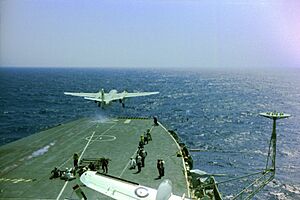
The main role of the Royal Australian Navy in the two decades after the Vietnam War was to support Australia's diplomatic efforts. To do this, the RAN trained with the navies of Australia's allies. It also helped civil authorities in Australia and the South Pacific. The RAN's main military worry from the 1970s was the activities of the Soviet Navy in the Indian Ocean. In 1971, the government of South Yemen allowed the Soviet Navy to use the former British naval base at Aden. This allowed the Soviet Navy to keep ships in the Indian Ocean. These worries led to more cooperation with the United States Navy. It also led to the development of the RAN's main base in Western Australia, HMAS Stirling.
In the late 1970s, the RAN replaced many of its old ships with modern ones. It planned to buy the British aircraft carrier HMS Invincible to replace Melbourne. However, Britain withdrew its offer after the Falklands War. As a result, Melbourne was taken out of service in 1982 without a replacement. The Fleet Air Arm stopped using almost all of its fixed-wing aircraft on 30 June 1983.
In 1987, the Hawke Government's Defence White Paper called for the RAN to become a more self-reliant two-ocean navy. This meant having major fleet bases in New South Wales and Western Australia. The plan called for expanding Stirling on Garden Island and Jervis Bay. This would allow them to hold an expanded RAN combat surface and submarine fleets. The plan originally aimed to split the main combat units and submarines between the two bases. This would provide similar capabilities on both sides of Australia. The proposed Jervis Bay naval base never happened. Fleet Base East was built around HMAS Kuttabul in Sydney. HMAS Stirling is now home to half the surface fleet and the entire submarine fleet.
The reason for this policy included possible savings in fuel and maintenance. Indian Ocean deployments would start from Western Australia instead of New South Wales. The report also said the Indian Ocean was an area where problems might arise. The new facilities would make Australia more valuable to the United States, especially for submarine maintenance. Expanding at Jervis Bay would allow more visits by the United States Pacific Fleet. Its nuclear warship visits would face less opposition than in Sydney and Melbourne.
The 1987 White Paper was seen by many as an attempt to strengthen Australia's relationship with the United States. This relationship had been damaged by New Zealand's stance against nuclear weapons in its ports. Following this policy, the RAN was set up to be more self-reliant. Its activities in the late 1980s focused on operating within Australia's local region.
The Two-Ocean Policy is still in place today. It is supported by the current Australian Government and the opposition. The success of the policy is clear at HMAS Stirling. The base is growing, and its location gives it an advantage over Fleet Base East. It has been suggested that all eight frigates be moved to Stirling. This would make training easier for sailors and save a lot of money.
The RAN After the Cold War
The Gulf Wars
Australia's contribution to the 1991 Gulf War was mainly a Naval Task Group. This group was part of the international fleet in the Persian Gulf and Gulf of Oman. Also, medical teams were sent to a US hospital ship. A naval clearance diving team helped clear mines from Kuwait's ports after the war. From 6 September 1990 to 4 September 1991, the RAN sent six ships to the area: HMA Ships Adelaide, Brisbane, Darwin, Success, Sydney, and Westralia. Clearance Diving Team 3 worked there from 27 January 1991 to 10 May 1991. They were involved in mine clearing in Kuwait from 5 March to 19 April 1991.
After the first Gulf War, the Royal Australian Navy regularly sent a ship to the Gulf or Red Sea. This was to help maintain sanctions against Iraq. Until the second Gulf War started, the Australian naval force in the Persian Gulf continued to enforce these sanctions. These operations were done by boarding parties from the RAN warships.
When the war started, the RAN's focus changed. It supported the coalition ground forces and cleared the way to Iraqi ports. HMAS Anzac provided gunfire support to Royal Marines during fighting on the Al-Faw Peninsula. The Clearance Diving Team helped clear the way to Umm Qasr. Boarding operations continued during the war. On 20 March, boarding parties from HMAS Kanimbla seized an Iraqi ship carrying 86 naval mines.
Since the end of the war, the RAN has continuously kept a frigate in the Persian Gulf. This is to protect Iraq's oil facilities and help stop smuggling. Twelve Australian sailors were sent to Umm Qasr, Iraq between January and October 2004. They joined a multinational training team working with the Iraqi Coastal Defense Force. The RAN has also commanded coalition forces in the Persian Gulf twice: Combined Task Force 58 in 2005 and Combined Task Force 158 in 2006.
East Timor Mission
During the Australian-led United Nations peacekeeping mission to East Timor in 1999, called INTERFET, the RAN sent 16 ships. These included HMA Ships Adelaide, Anzac, Balikpapan, Brunei, Darwin, Farncomb, Jervis Bay, Labuan, Success, Sydney, Tarakan, Tobruk, Waller, Westralia, Newcastle and Melbourne. The RAN played a very important role in transporting troops and protecting transport ships. They were vital to INTERFET's success.
The RAN returned to East Timor in 2006 under Operation Astute. This was a UN-approved, Australian-led military mission. Its goal was to stop unrest and bring stability during the 2006 East Timor crisis. The Royal Australian Navy sent the Amphibious Ready Group. This included the ships; Kanimbla, Manoora, Tobruk (until about 8 June), Balikpapan, Tarakan, and Success (until 28 May). The RAN also sent the frigate HMAS Adelaide (until 28 May). The Fleet Air Arm provided one S-70B-2 Seahawk helicopter and two Sea King helicopters. The Royal Australian Navy force sent to Operation Astute was the largest amphibious task force in the navy's history.
Solomon Islands Mission
On 24 July 2003, HMAS Manoora arrived off Honiara. This marked the start of Operation Anode, Australia's help for the Regional Assistance Mission to the Solomon Islands (RAMSI). A 2,200-strong multinational force was sent after several years of unrest in the Solomon Islands. Manoora was soon joined by HMA Ships Hawkesbury, Labuan, Wewak, and Whyalla. After the first deployment, two ships usually stayed in the area. By the time the RAN mission ended, 19 Australian warships had taken part. The last ship to leave was Fremantle, which sailed home in October 2004.
Operation Anode was not the first time RAN units had been sent to the Solomon Islands. However, Anode was special because the navy's main job was to support the police-led mission.
Fiji Mission
On 2 November 2006, the Australian government started Operation Quickstep. This was in response to the Fijian military threatening to overthrow the government. Australia sent military resources to help Australian citizens in Fiji if a coup happened. The RAN sent three ships (Kanimbla, Newcastle, and Success) to international waters south of Fiji. Their mission was to evacuate the estimated 7,000 Australian citizens in Fiji if needed. Along with the three ships, a group from the Special Air Service Regiment (SASR), helicopters, and an evacuation team were also sent.
On 29 November 2006, an Australian Army helicopter operating from Kanimbla crashed while trying to land on the ship's deck. It killed 1 person, injured 7, and left one missing (later confirmed dead). Melville arrived on 15 December 2006. It had special equipment from the US Navy to find the crashed helicopter. Melville found the helicopter's beacon on its first pass over the crash site. It was sitting in about 2,900 meters (9,500 ft) of water.
The coup happened on 5 December. It was peaceful and almost without violence. The evacuation of Australians was not needed. Ships from the task force started arriving back in Australia on 17 December. Kanimbla docked in Townsville, and Newcastle and Success returned to Sydney. Melville returned to Australia in late December. The RAN decided to try and recover the crashed helicopter. The helicopter was recovered on 9 March.
Battle Honours and Women in the RAN
Battle Honours
Before 1989, the battle honour system for the Royal Australian Navy (RAN) was linked to that of the Royal Navy. The British Ministry of Defence and the British Navy were responsible for approving and giving out battle honours. However, from 1947, this was done with advice from the RAN Badges, Names and Honours Committee. The only unique Australian battle honour during this time was "Vietnam 1965–72" for service in the Vietnam War. RAN ships inherited honours from British ships with the same name, as well as Australian ships that came before them.
In 1989, the Chief of Naval Staff, Admiral Michael Hudson, approved a decision. Australian warships would only carry battle honours earned by previous Australian vessels. The creation and awarding of battle honours came completely under RAN control.
A complete update of the RAN battle honours system was revealed on 1 March 2010. This was to celebrate the navy's 109th anniversary. New honours were created for operations during the 1990s and 2000s. The last approved honour before this was "Kuwait 1991" for Gulf War service. The service history of previous ships was updated to include 'proper recognition' of past actions.
Women in the RAN
From 1911 to 1941, women were not allowed to serve in the RAN. The demands of World War II on people and resources led to a change in policy. On 21 April 1941, the Australian Naval Board allowed women to join the RAN. This led to the formation of the Women's Royal Australian Naval Service (WRANS) and the Royal Australian Naval Nursing Service (RANNS). These two separate women's services existed until 1984. Then, they were fully included into the permanent force. Today, female members of the RAN have many different roles open to them. Women serve on submarines, command ships and shore bases. They are expected to play an increasingly important role in the future of the RAN.
The Royal Australian Navy today is a modern navy of medium size in world terms. However, it is one of the strongest navies in the Asia Pacific Region. The RAN's fighting fleet has three destroyers, eight frigates, twelve patrol boats, and six submarines. The RAN also has ships to transport the Australian Army and resupply the navy's combat ships.
The RAN is divided into seven groups: Surface Combatants, Amphibious Warfare Forces and Afloat Support Force, Naval Aviation, Submarine Force, Mine Warfare and Clearance Diving, Patrol Boat Force, and the Hydrographic Force. These groups were formed to manage the RAN's operations more efficiently.

The modern RAN began to form in the late 1970s. The Fraser Government announced the purchase of four frigates, all to be built in America. In 1980, they announced two more ships, both to be built in Australia. The fifteen Australian-built patrol boats made up Australia's patrol boat fleet from 1979 to 2007. They have now been replaced by fourteen newer patrol boats.
The Collins class is the newest class of Australian submarines. They were built in Australia for the Royal Australian Navy. They replaced the six older submarines in the Australian fleet. The first submarine, HMAS Collins, was started in 1990 and joined the navy in 1996. All six submarines are now in service and based at HMAS Stirling in Western Australia.
The Anzac class is currently the main ship type in the Royal Australian Navy. There are eight ships in this class. The first ship, HMAS Anzac, joined the navy in 1996. The last ship, HMAS Perth, joined on 26 August 2006. Along with the eight Australian ships, two Anzacs were also built for the Royal New Zealand Navy. The Anzac class ships were built together in New Zealand and Australia.
The RAN's amphibious and supply section includes; HMAS Choules, a large landing ship, HMAS Adelaide and HMAS Canberra, which are large helicopter dock ships. It also has twelve landing craft, two survey vessels, four motor launches, the fleet oiler HMAS Sirius, and the supply ship HMAS Success. The RAN also has six minehunters.
The Royal Australian Navy has several bases around Australia. Under the RAN's Two-Ocean Policy, HMAS Stirling (Fleet Base West) and HMAS Kuttabul (Fleet Base East) are the main bases for all major RAN fleet ships. Most of the patrol boat and amphibious forces are at HMAS Cairns and HMAS Coonawarra. All Fleet Air Arm squadrons are based at HMAS Albatross.
Images for kids


